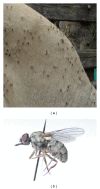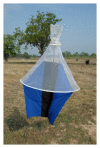Trypanosoma evansi and surra: a review and perspectives on transmission, epidemiology and control, impact, and zoonotic aspects
- PMID: 24151595
- PMCID: PMC3789323
- DOI: 10.1155/2013/321237
Trypanosoma evansi and surra: a review and perspectives on transmission, epidemiology and control, impact, and zoonotic aspects
Abstract
This paper reviews the transmission modes of Trypanosoma evansi. Its worldwide distribution is attributed to mechanical transmission. While the role of tabanids is clear, we raise questions on the relative role of Haematobia sp. and the possible role of Stomoxys sp. in delayed transmission. A review of the available trypanocidal drugs and their efficacy in various host species is useful for understanding how they interact in disease epidemiology, which is complex. Although there are similarities with other mechanically transmitted trypanosomes, T. evansi has a more complex epidemiology due to the diversity of its hosts and vectors. The impact of clinical and subclinical disease is difficult to establish. A model was developed for buffaloes in the Philippines, which could be transferred to other places and livestock systems. Since Trypanosoma evansi was reported in humans, further research is required to investigate its zoonotic potential. Surra remains a potentially emerging disease that is a threat to Australia, Spain, and France. A number of questions about the disease have yet to be resolved. This brief review of the basic knowledge of T. evansi suggests that there is renewed interest in the parasite, which is spreading and has a major economic impact.
Figures







References
-
- Gill B. Trypanosomes and Trypanosomiases of Indian Livestock. 1st edition. Edited by ICAR. New Delhi, India: Indian Council of Agricultural Research; 1977.
-
- Foil LD, Adams WV, McManus JM, Issel CJ. Bloodmeal residues on mouthparts of Tabanus fuscicostatus and the potential for mechanical transmission of pathogens. Journal of Medical Entomology. 1987;24(6):613–616. - PubMed
-
- Desquesnes M, Biteau-Coroller F, Bouyer J, Dia ML, Foil L. Development of a mathematical model for mechanical transmission of trypanosomes and other pathogens of cattle transmitted by tabanids. International Journal for Parasitology. 2009;39(3):333–346. - PubMed
-
- Krinsky WL. Animal disease agents transmitted by horse flies and deer flies (Diptera: Tabanidae) Journal of Medical Entomology. 1976;13(3):225–275. - PubMed
Publication types
MeSH terms
LinkOut - more resources
Full Text Sources
Other Literature Sources

